Experiment and Numerical Prediction on Shock Sensitivity of HMX–Based Booster Explosive with Small Scale Gap Test at Low and Elevated Temperatures
Abstract
:1. Introduction
2. Materials and Methods
2.1. Experiment
2.1.1. Materials and Instruments
2.1.2. Preparation and Characterization of HMX–Based Booster Explosives
2.1.3. Temperature Calibration Experiment
2.1.4. SSGT Set Up
2.2. SSGT Modeling and Simulation
2.2.1. Modeling
2.2.2. Reactive Flow Modeling
3. Results and Discussion
3.1. Experimental Results at Low and Elevated Temperatures
3.2. Experimental Results at Non-Ambient Temperature
3.3. Prediction of Shock Sensitivity of HMX–Based Booster at Different Temperatures
3.4. Mechanism Analysis of Temperature Effect on Shock Sensitivity of HMX–Based Booster
4. Conclusions
Author Contributions
Funding
Institutional Review Board Statement
Informed Consent Statement
Data Availability Statement
Conflicts of Interest
References
- Xu, Z.X.; Qin, Z.C.; Wang, C.; Zhou, B. Development Situation of Booster at Home and Abroad. Fireworks 1995, 3, 29–32. [Google Scholar]
- Sun, G.X.; Dai, R.G.; Chen, L.Y. Overview of the development of domestic and foreign explosives—The development of varieties of explosives. Mod. Cit. 1995, 1, 56–64. [Google Scholar]
- Feng, G.T. Introduction to the Research of Explosive Transmitters in China. Fireworks 1999, 2, 49–51. [Google Scholar]
- Shi, J.; Liu, J.H.; Bai, L.F. In-situ temperature-varying X-ray small-angle scattering of HMX crystal particle microstructures. Chin. J. Energ. Mater. 2020, 28, 848–853. [Google Scholar]
- Urtiew, P.A.; Tarver, C.M.; Forbes, J.W.; Garcia, F. Shock sensitivity of LX-04 at elevated temperatures. Am. J. Phys. 1998, 429, 727–730. [Google Scholar]
- Forbes, J.W.; Tarver, C.M.; Urtiew, G. The Effects of Confinement and Temperature on the Shock Sensitivity of Solid Explosives; Lawrence Livermore National Lab. (LLNL): Livermore, CA, USA, 1998. [Google Scholar]
- Urtiew, P.A.; Tarver, C.M. Shock initiation of energetic materials at different initial temperatures (review). Combust. Explos. Shock Waves 2005, 41, 766–776. [Google Scholar] [CrossRef]
- Ayres, J.N.; Montesi, L.J.; Bauer, R.J. Small Scale Gap Test (SSGT) Data Compilation. Military Technology, Weaponry and National Defense Chemical Explosions and Explosives; Naval Ordnance Lab.: White Oak, MD, USA, 1973. [Google Scholar]
- Tarver, C.M.; Forbes, J.W.; Urtiew, P.A.; Garcia, F. Shock Sensitivity of LX-04 at 150 °C. Am. J. Phys. 2000, 505, 891–894. [Google Scholar]
- Tarver, C.M.; Forbes, J.W.; Urtiew, P.A.; Garcia, F. Manganin gauge and reactive flow modeling study of the shock initiation of PBX 9501. Am. J. Phys. 2002, 620, 1043–1046. [Google Scholar]
- Urtiew, P.A.; Forbes, J.W.; Tarver, C.M.; Vandersall, K.S.; Garcia, F.; Greenwood, D.W.; Maienschein, J.L. Shock Sensitivity of LX-04 Containing Delta Phase HMX at Elevated Temperatures. Am. J. Phys. 2004, 706, 1053–1056. [Google Scholar]
- Urtiew, P.A.; Vandersall, K.S.; Tarver, C.M.; Garcia, F. Initiation of Heated PBX-9501 Explosive When Exposed to Dynamic Loading. In Proceedings of the Zababakhin Scientific Talks, Snezhinsk, Russia, 10 September 2005. [Google Scholar]
- Vandersall, K.S.; Tarver, C.M.; Urtiew, P.A. Shock initiation experiments on PBX9501 explosive at 150 °C for ignition and growth model. Am. J. Phys. 2006, 845, 1127–1130. [Google Scholar]
- Chakravarty, A.; Proud, W.G.; Field, J.E. Small scale gap testing of novel compositions. Am. J. Phys. 2004, 706, 935–938. [Google Scholar]
- Arnold, W.; Muthig, H. What influences the shock sensitivity of high explosives? Insensitive Munitions Energetic Mater. Technol. Symp. 2006, 61, 62–63. [Google Scholar]
- Keshavarz, M.H.; Motamedoshariati, H.; Pouretedal, H.R.; Tehrani, M.K.; Semnani, A. Prediction of shock sensitivity of explosives based on small-scale gap test. J. Hazard. Mater. 2007, 145, 109–112. [Google Scholar] [CrossRef] [PubMed]
- Chen, L.; Liu, Q.; Wu, J.Y. On shock initiation of heated explosives. Explos. Shock Waves 2013, 33, 21–28. [Google Scholar]
- Wang, C.; Chen, L.; Wu, J.Y.; Liu, Q.; Hu, X.M. Shock to Initiation Characters of Heated Explosives with Different Confinement. Propellants Explos. Pyrotech. 2016, 41, 383–392. [Google Scholar] [CrossRef]
- Chuzeville, V.; Baudin, G.; Lefrancois, A.; Genetier, M.; Barbarin, Y.; Jacquet, L.; Catoire, L. Detonation initiation of heterogeneous melt-cast high explosives. In Proceedings of the 19th American Physical Society Topical Conference on Shock Compression of Condensed Matter, Tampa Bay, FL, USA, 13 January 2017. [Google Scholar]
- Sutherland, G.T. Modeling of large scale and expanded large scale gap tests using the CTH hydrocode. Am. J. Phys. 2009, 1195, 369–372. [Google Scholar]
- Verbeek, R.; Bouma, R.H. Evaluation of the energy fluence in the small scale gap test. Propellants Explos. Pyrotech. 2011, 36, 16–21. [Google Scholar] [CrossRef]
- Wu, M.L.; Liu, Y.C. Numerical Modeling of Shock Sensitivity Experiments (SSGT). Initiat. Pyrotech. 2004, 2, 16–19. [Google Scholar]
- Li, S.; Yuan, J.M.; Liu, Y.C. Experiment and Numerical Simulation of Shock Initiation of JH-14C Detonation Device. Propellants Explos. Pyrotech. 2016, 39, 63–68. [Google Scholar]
- Kim, B.; Jang, S.; Yoh, J.J. A full-scale hydrodynamic simulation of energetic component system. Comput. Fluids 2017, 156, 368–383. [Google Scholar] [CrossRef]
- Yuan, J.M.; Li, S.; Liu, Y.C.; Tang, X.; Yu, Y.W.; Yan, L.W. Sympathetic detonation of booster pipe with JO–9C charge. Explos. Shock Waves 2018, 38, 632–638. [Google Scholar]
- Tan, K.Y.; Wen, S.G.; Han, Y. Shock Initiation Characteristics of Explosives at Near-ambient Temperatures. Chin. J. Energ. Mater. 2016, 24, 905–910. [Google Scholar]
- Kim, B.; Park, J.; Yoh, J.J. Analysis on shock attenuation in gap test configuration for characterizing energetic materials. J. Appl. Phys. 2016, 119, 14. [Google Scholar] [CrossRef]
- Sutherland, G.T.; Benjamin, R.; Kooker, D. Simulations of the modified gap experiment. In Proceedings of the 19th American Physical Society Topical Conference on Shock Compression of Condensed Matter, Tampa Bay, FL, USA, 13 January 2017. [Google Scholar]
- Yang, K.; Chen, L.; Liu, D.Y.; Geng, D.S.; Lu, J.Y.; Wu, J.Y. Quantitative prediction and ranking of the shock sensitivity of explosives via reactive molecular dynamics simulations. Def. Technol. 2022, 18, 843–845. [Google Scholar] [CrossRef]
- Yang, Y.; Duan, Z.P.; Li, S.R.; Zhang, L.S.; Huang, F.L.; Han, Y.; Huang, H. A new Ignition-Growth reaction rate model for shock initiation. Def. Technol. 2023, 23, 126–136. [Google Scholar] [CrossRef]
- Yuan, J.; Qin, Y.; Liu, Y.; Sun, H.; Huang, R.; Wang, J.; Han, T.; Wu, R. Friction Sensitivity Test Experiment and Desensitization Mechanism of Nitrocellulose-Coated DNTF Explosive Crystals. Coatings 2023, 13, 1721. [Google Scholar] [CrossRef]
- GJB 2178-97; Technology and Industry for National Defense. Safety Tests for Booster. Standard Press of China: Beijing, China, 1994; pp. 3–7.
- Tarver, C.M.; Hallquist, J.O.; Erickson, L.M. Modeling short pulse duration shock initiation of solid explosives. In Proceedings of the International Symposium on Detonation, Albuquerque, NM, USA, 15 July 1985. [Google Scholar]
- Lee, E.; Finger, M.; Collins, W. JWL equation of state coefficients for high explosives[R]. In Proceedings of the Symposium on Detonation, Lawrence Livermore National Lab (LLNL), Livermore, CA, USA, 6 January 1973. [Google Scholar]
- Tian, X.Q.; Yuan, J.M.; Zhang, F.F.; Zhao, W.; Xu, N. Experimental study on JO–9C explosive charge spacer under different temperature environment. J. Rocket Force Eng. Univ. (Nat. Sci. Ed.) 2020, 1, 6. [Google Scholar]
- Li, S. Study on the Safe Evaluation of Ammunition Detonation Sequence under Shock Wave. Master’s Thesis, North University of China, Taiyuan, China, 2017. [Google Scholar]
- Tarver, C.M.; McGuire, E.M. Reactive Flow Modeling of the Interaction of TATB Detonation Waves with Inert Materials. In Proceedings of the 12 International Detonation Symposium, San Diego, CA, USA, 1 July 2002. [Google Scholar]
- Dai, X.; Wen, Y.; Shen, C. Response characteristics of PBX-2 explosives in combined thermal and gunshot environment test. Chin. J. Explos. Propellants 2009, 32, 41–44. [Google Scholar]
- Chi, J.C.; Liu, Y.S.; Gong, Y.Q.; Li, Q. Experimental study on the development of pressure field of impact detonation of JB9014 explosives at room temperature and −54 °C low temperature. J. High Press. Phys. 2001, 15, 39–47. [Google Scholar]
- Dai, X.G.; Wen, Y.S.; Huang, F.L.; Huang, H.; Huang, Y.M. Effect of Temperature, Density and Confinement on Deflagration to Detonation Transition of an HMX based Explosive. Propellants Explos. Pyrotech. 2014, 39, 563–567. [Google Scholar] [CrossRef]
- Dai, X.G.; Yu, S.J.; Huang, F.L.; Wen, Y.S.; Zhen, X.; Yao, K.G. Impact response characteristics of PBX-2 explosive projectiles at room temperature and 75 °C. Chin. J. Energ Mater 2017, 25, 683–688. [Google Scholar]
- Dai, X.G.; Wen, Y.S.; Huang, H.; Zhang, P.J.; Wen, M.P. Impact response characteristics of a cyclotetramethylene tetranitramine based polymer-bonded explosives under different temperatures. J. Appl. Phys. 2013, 114, 1065–1068. [Google Scholar]
- Dai, X.G.; Wang, J.; Wen, Y.S. Combustion trans burst characteristics of PBX-2 explosives under heating conditions. Chin. J. Energ. Mater. 2013, 21, 649–652. [Google Scholar]
- Cady, H.H.; Smith, L.C. Studies on the Polymorphs of HMX; Los Alamos Scientific Laboratory of the University of California: Santa Fe, MN, USA, 1962; Volume 2652. [Google Scholar]
- Sandusky, H.W.; Granholm, R.H.; Bohl, D.G.; Vandersall, K.S.; Hare, D.E.; Garcia, F. Deflagration-to-Detonation Transition in LX-04 as a Function of Loading Density, Temperature, and Confinement; Lawrence Livermore National Lab. (LLNL): Livermore, CA, USA, 2006. [Google Scholar]
- Maienschein, J.L.; Koerner, J.G. Deflagration Behavior of PBX 9501 at Elevated Temperature and Pressure; Lawrence Livermore National Lab. (LLNL): Livermore, CA, USA, 2008. [Google Scholar]
- Smilowitz, L.; Henson, B.F.; Greenfield, M. On the nucleation mechanism of the β-δ phase transition in the energetic nitramine octahydro-1,3,5,7-tetranitro-1,3,5,7-tetrazocine. J. Chem. Phys. 2004, 121, 5550–5552. [Google Scholar] [CrossRef] [PubMed]
- Ma, X.G. Shock wave susceptibility of explosives—Spacer test. Chin. J. Explos. Propellants 1982, 5, 1–6. [Google Scholar]
- Tang, M.F.; Wen, M.P.; Tu, X.Z. The influence law and mechanism analysis of high temperature and mechanical stress on the mechanical behaviour of PBX. Chin. J. Energ. Mater. 2018, 26, 150–155. [Google Scholar]
- Tu, X.Z.; Li, W.; Wei, X.W. Blast performance of TATB-based polymer bonded explosives at 75 °C. Chin. J. Energ. Mater. 2013, 21, 653–655. [Google Scholar]

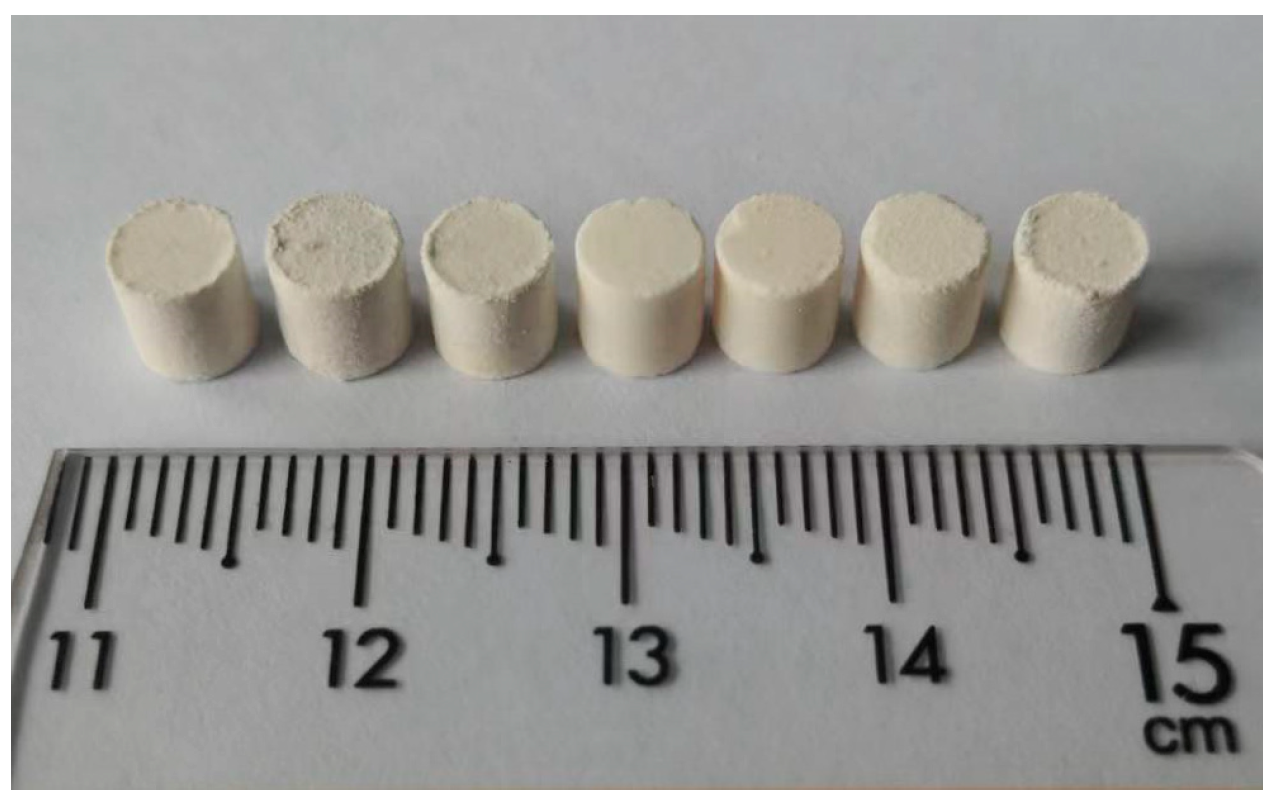
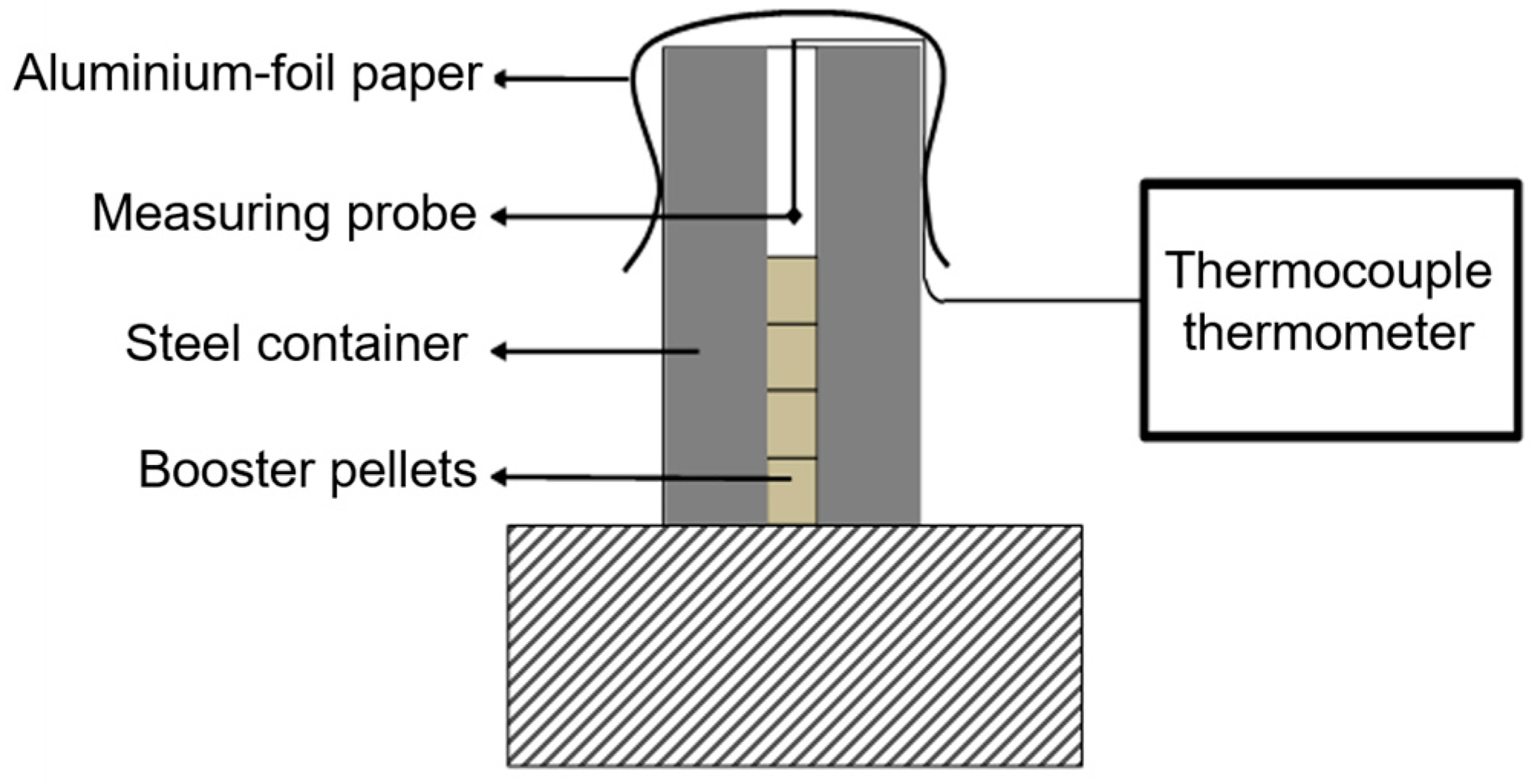
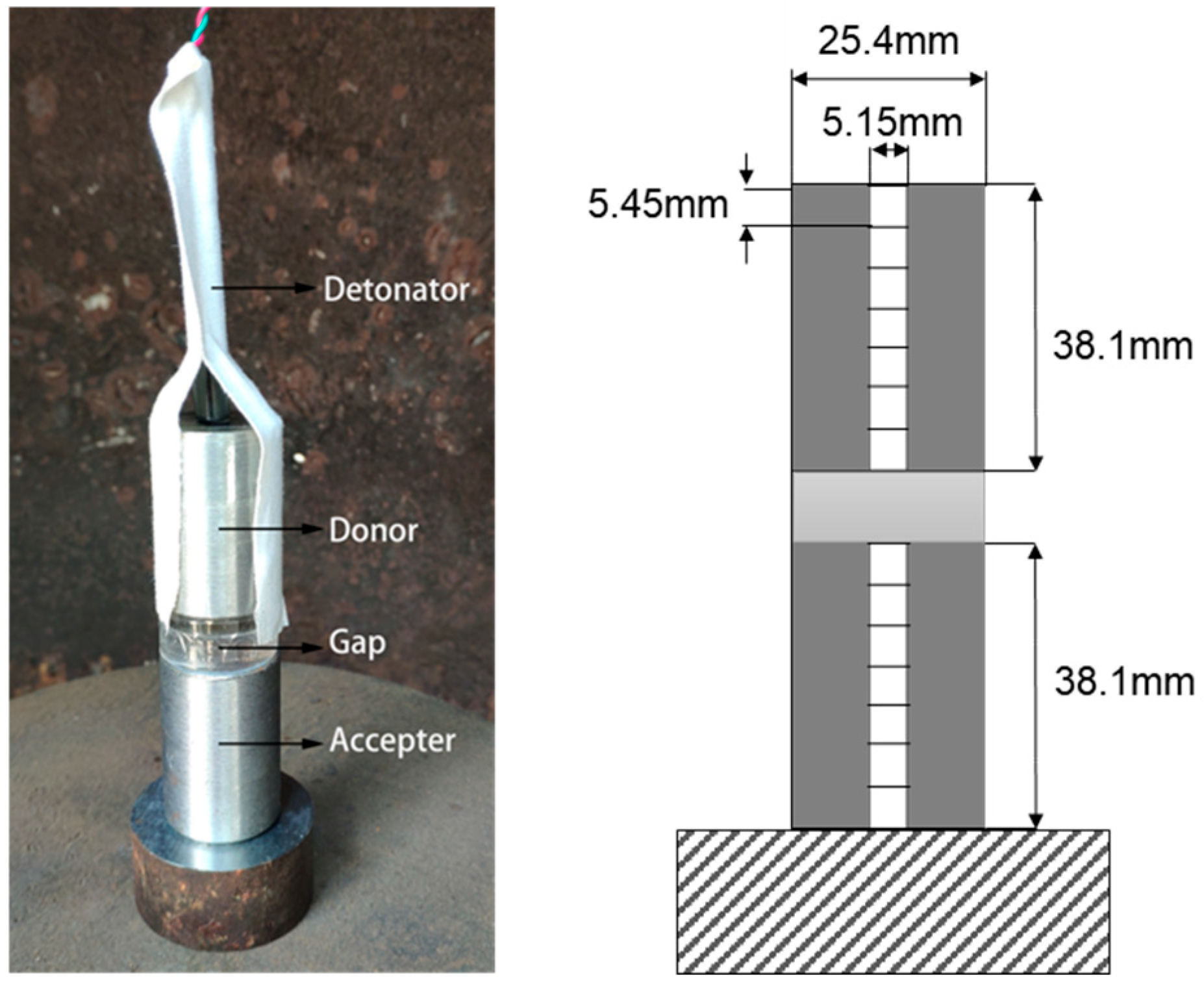
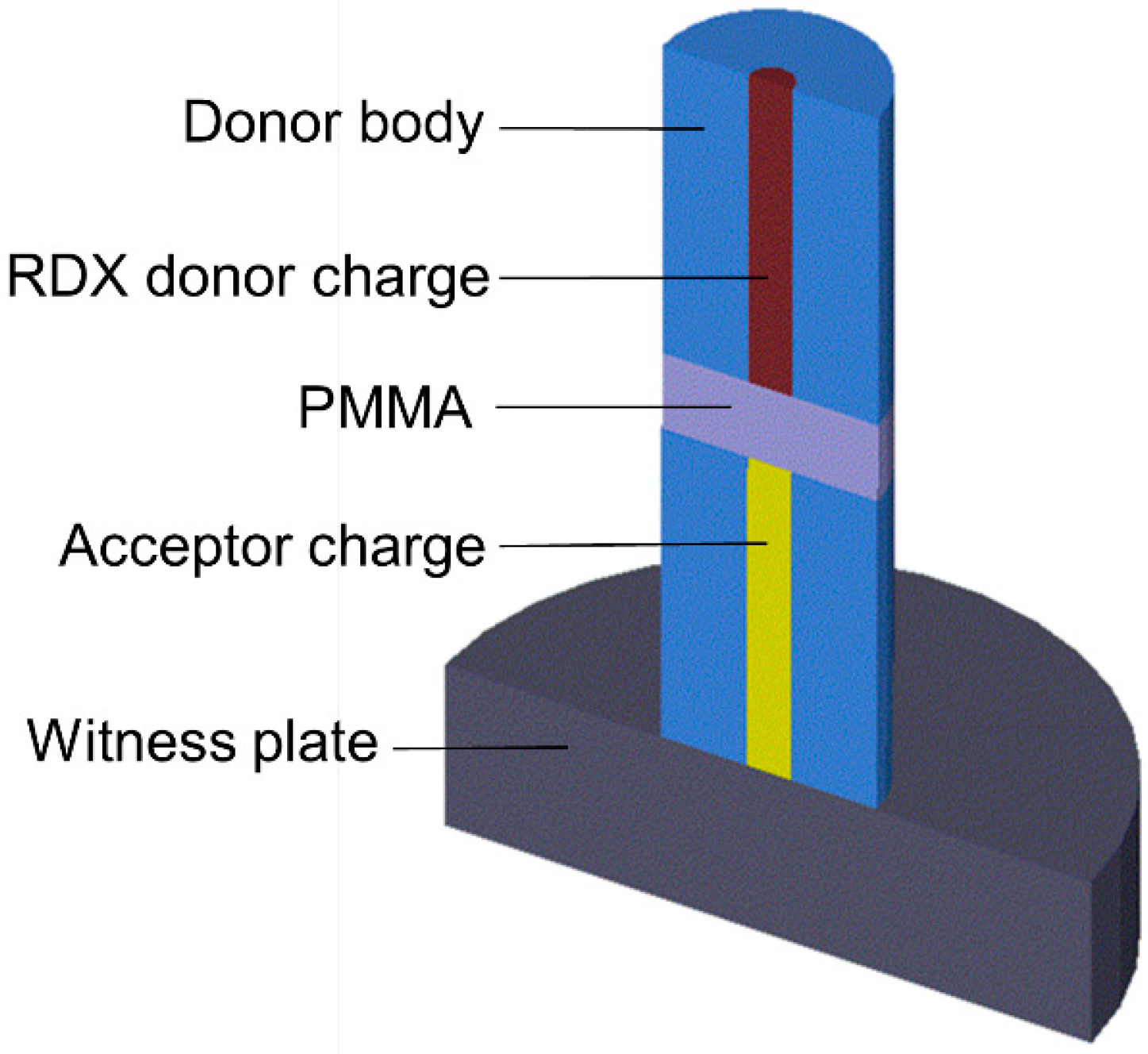
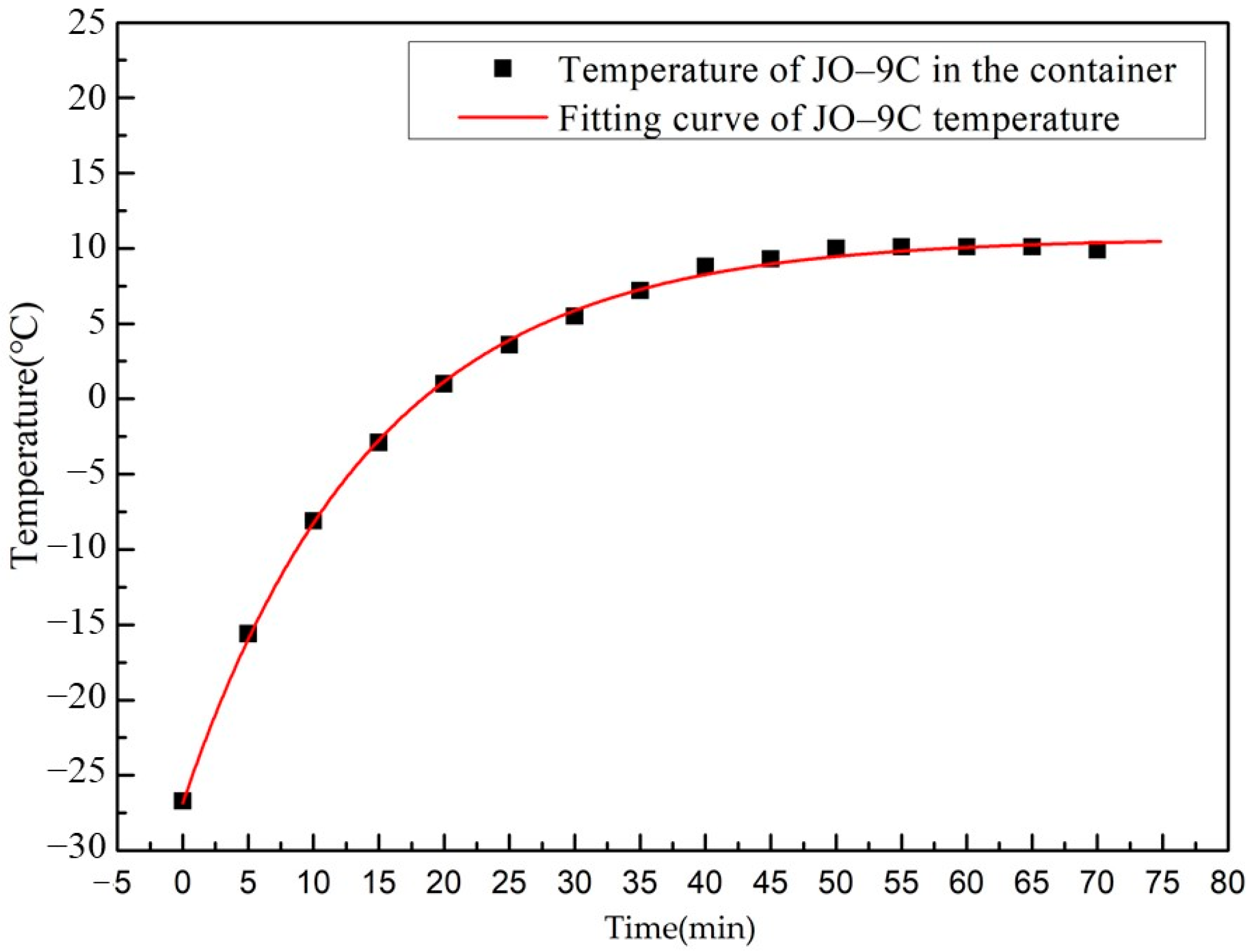




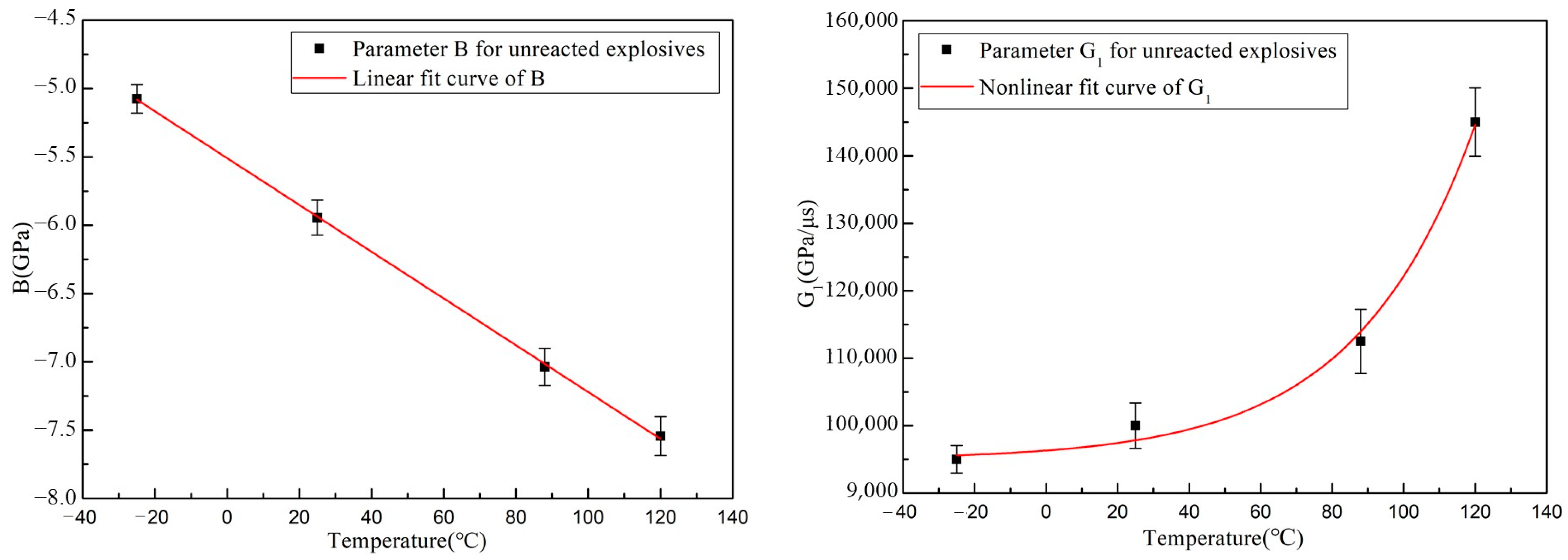

| Name | Specifications | Manufacturer |
|---|---|---|
| JO–9C | 100~300 μm | Chinese weapons industry booster explosive performance testing center laboratory (Taiyuan, China) |
| ethyl acetate | 500 mL | China National Pharmaceutical Group Chemical Reagent Co., Ltd. (Beijing, China) |
| Fluorine Rubber (FPM2602) | 500 g | Liming Research Institute of Chemical Industry (Luoyang, China) |
| HMX | d50 = 50 μm | Gansu Yinguang Arms Group 805 Factory (Gansu, China) |
| Name | Specifications | Manufacturer |
|---|---|---|
| electronic analytical balance | DT-100A; accuracy value 0.0001 g | Shanghai Jingke Electronics Co., Ltd. (Shanghai, China) |
| PLUS scanning electron microscope | SEM-30 | Beijing Tianyao Technology Co., Ltd. (Beijing, China) |
| Transmission electron microscope | Tecnai 12 | Shanghai Shengxi Hardware and Electromechanical Co., Ltd. (Shanghai, China) |
| Hydraulic presses | 50 T | Woda Heavy Industry Company (Zaozhuang, China) |
| polymethyl methacrylate (PMMA) | Φ 40 mm | Suzhou Yilan Microelectronics Co., Ltd. (Suzhou, China) |
| Industrial Fire Detonator | 24 V | Xi’an Northern Qinghua Electromechanical Group (Xi’an, China) |
| Steel Sleeve | Inner diameter: Φ 5.15 mm; Outer diameter 25.40; Height: 38.10 mm | Zibo Xinshengxin Pipe Industry Co., Ltd. (Zibo, China) |
| contact type industrial high-temperature thermometer based on K-type thermocouple | DT1311. measurement range: –50~100 °C, accuracy value: 0.1 °C | Wenzhou Hanbang Electronics Co., Ltd. (Wenzhou, China) |
| circulating water vacuum pump | SHZ–D(II) type | Henan Gongyi Yingyu Yuhua Instrument Factory (Gongyi, China) |
| Exp/num | Depth of Dent/mm |
|---|---|
| 1 | 1.90 |
| 2 | 1.74 |
| 3 | 1.81 |
| Exp/num | PMMA Gap Thickness/mm | Depth of Dent/mm | Go/No Go |
|---|---|---|---|
| 1 | 6.8 | 0.22 | No go |
| 2 | 5.9 | 1.46 | Go |
| 3 | 6.5 | 0.44 | No go |
| 4 | 6.3 | 1.68 | Go |
| 5 | 6.4 | 0.34 | No go |
| Exp/num | PMMA Gap Thickness/mm | Depth of Dent/mm | Go/No Go |
|---|---|---|---|
| 1 | 9.4 | 0.02 | No go |
| 2 | 9.1 | 0.04 | No go |
| 3 | 8.4 | 0.44 | No go |
| 4 | 8.0 | 0.20 | No go |
| 5 | 7.5 | 1.76 | Go |
| 6 | 7.8 | 0.36 | No go |
| Exp/num | PMMA Gap Thickness/mm | Depth of Dent/mm | Go/No Go |
|---|---|---|---|
| 1 | 9.0 | 0.16 | No go |
| 2 | 8.0 | 0.06 | Go |
| 3 | 8.5 | 1.76 | No go |
| 4 | 8.2 | 1.76 | Go |
| 5 | 8.3 | 1.48 | Go |
| 6 | 8.4 | 0.38 | No go |
| UNREACTED JWL | REACTED JWL | ||
| (GPa) | 95,220 | (GPa) | 614 |
| (GPa) | –5.944 | (GPa) | 10.89 |
| 14.1 | 4.41604 | ||
| 1.41 | 1.19 | ||
| 0.8867 | 0.33 | ||
| 298 K | 9.08 | ||
| Shear Modulus (GPa) | 5 | (m/s) | 8212.5 |
| Yield Stress (GPa) | 0.2 | (GPa) | 30.4 |
| 1.700 | |||
| REACTION RATES | |||
| ) | 4 × 105 | 1.0 | |
| 0.667 | 3.0 | ||
| 0.113 | 0.1 | ||
| 4.0 | 0.5 | ||
| 0.667 | 0.5 | ||
| 0.667 | (GPa/μs) | 100,000 | |
| 2.0 | (GPa/μs) | 32,000 | |
| 0.333 | |||
| (°C) | (GPa) | (GPa/μs) |
|---|---|---|
| −25 | –5.0750 ± 0.104 | 95,000 ± 2058 |
| 25 | –5.9440 ± 0.128 | 100,000 ± 3359 |
| 88 | –7.0384 ± 0.136 | 112,500 ± 4740 |
| 120 | –7.5425 ± 0.141 | 145,000 ± 5061 |
Disclaimer/Publisher’s Note: The statements, opinions and data contained in all publications are solely those of the individual author(s) and contributor(s) and not of MDPI and/or the editor(s). MDPI and/or the editor(s) disclaim responsibility for any injury to people or property resulting from any ideas, methods, instructions or products referred to in the content. |
© 2024 by the authors. Licensee MDPI, Basel, Switzerland. This article is an open access article distributed under the terms and conditions of the Creative Commons Attribution (CC BY) license (https://creativecommons.org/licenses/by/4.0/).
Share and Cite
Yuan, J.; Linghu, J.; Han, P.; Tian, X.; Wang, N.; Yang, Q.; Yang, J. Experiment and Numerical Prediction on Shock Sensitivity of HMX–Based Booster Explosive with Small Scale Gap Test at Low and Elevated Temperatures. Appl. Sci. 2024, 14, 8964. https://doi.org/10.3390/app14198964
Yuan J, Linghu J, Han P, Tian X, Wang N, Yang Q, Yang J. Experiment and Numerical Prediction on Shock Sensitivity of HMX–Based Booster Explosive with Small Scale Gap Test at Low and Elevated Temperatures. Applied Sciences. 2024; 14(19):8964. https://doi.org/10.3390/app14198964
Chicago/Turabian StyleYuan, Junming, Jiangqi Linghu, Peijiang Han, Xiuqi Tian, Nan Wang, Qi Yang, and Jia Yang. 2024. "Experiment and Numerical Prediction on Shock Sensitivity of HMX–Based Booster Explosive with Small Scale Gap Test at Low and Elevated Temperatures" Applied Sciences 14, no. 19: 8964. https://doi.org/10.3390/app14198964





